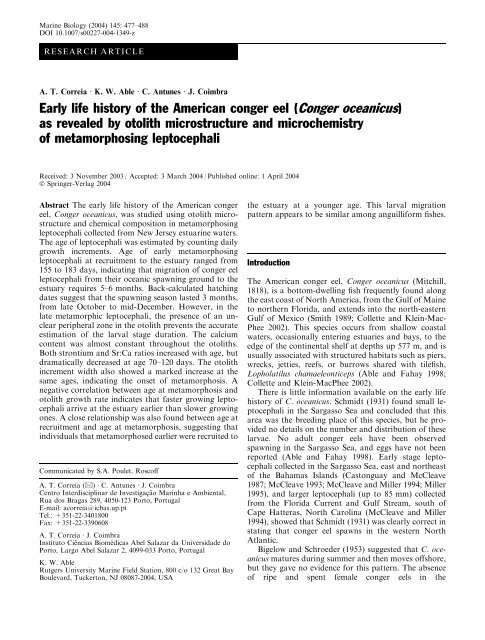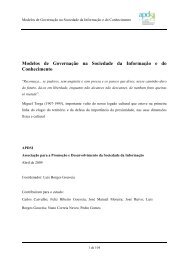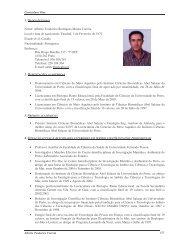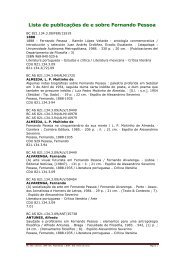Early life history of the American conger eel ... - ResearchGate
Early life history of the American conger eel ... - ResearchGate
Early life history of the American conger eel ... - ResearchGate
You also want an ePaper? Increase the reach of your titles
YUMPU automatically turns print PDFs into web optimized ePapers that Google loves.
Marine Biology (2004) 145: 477–488DOI 10.1007/s00227-004-1349-zRESEARCH ARTICLEA. T. Correia Æ K. W. Able Æ C. Antunes Æ J. Coimbra<strong>Early</strong> <strong>life</strong> <strong>history</strong> <strong>of</strong> <strong>the</strong> <strong>American</strong> <strong>conger</strong> <strong>eel</strong> (Conger oceanicus)as revealed by otolith microstructure and microchemistry<strong>of</strong> metamorphosing leptocephaliReceived: 3 November 2003 / Accepted: 3 March 2004 / Published online: 1 April 2004Ó Springer-Verlag 2004Abstract The early <strong>life</strong> <strong>history</strong> <strong>of</strong> <strong>the</strong> <strong>American</strong> <strong>conger</strong><strong>eel</strong>, Conger oceanicus, was studied using otolith microstructureand chemical composition in metamorphosingleptocephali collected from New Jersey estuarine waters.The age <strong>of</strong> leptocephali was estimated by counting dailygrowth increments. Age <strong>of</strong> early metamorphosingleptocephali at recruitment to <strong>the</strong> estuary ranged from155 to 183 days, indicating that migration <strong>of</strong> <strong>conger</strong> <strong>eel</strong>leptocephali from <strong>the</strong>ir oceanic spawning ground to <strong>the</strong>estuary requires 5–6 months. Back-calculated hatchingdates suggest that <strong>the</strong> spawning season lasted 3 months,from late October to mid-December. However, in <strong>the</strong>late metamorphic leptocephali, <strong>the</strong> presence <strong>of</strong> an unclearperipheral zone in <strong>the</strong> otolith prevents <strong>the</strong> accurateestimation <strong>of</strong> <strong>the</strong> larval stage duration. The calciumcontent was almost constant throughout <strong>the</strong> otoliths.Both strontium and Sr:Ca ratios increased with age, butdramatically decreased at age 70–120 days. The otolithincrement width also showed a marked increase at <strong>the</strong>same ages, indicating <strong>the</strong> onset <strong>of</strong> metamorphosis. Anegative correlation between age at metamorphosis andotolith growth rate indicates that faster growing leptocephaliarrive at <strong>the</strong> estuary earlier than slower growingones. A close relationship was also found between age atrecruitment and age at metamorphosis, suggesting thatindividuals that metamorphosed earlier were recruited toCommunicated by S.A. Poulet, Rosc<strong>of</strong>fA. T. Correia (&) Æ C. Antunes Æ J. CoimbraCentro Interdisciplinar de Investigac¸ão Marinha e Ambiental,Rua dos Bragas 289, 4050-123 Porto, PortugalE-mail: acorreia@icbas.up.ptTel.: +351-22-3401800Fax: +351-22-3390608A. T. Correia Æ J. CoimbraInstituto Cieˆ ncias Biomédicas Abel Salazar da Universidade doPorto, Largo Abel Salazar 2, 4099-033 Porto, PortugalK. W. AbleRutgers University Marine Field Station, 800 c/o 132 Great BayBoulevard, Tuckerton, NJ 08087-2004, USA<strong>the</strong> estuary at a younger age. This larval migrationpattern appears to be similar among anguilliform fishes.IntroductionThe <strong>American</strong> <strong>conger</strong> <strong>eel</strong>, Conger oceanicus (Mitchill,1818), is a bottom-dwelling fish frequently found along<strong>the</strong> east coast <strong>of</strong> North America, from <strong>the</strong> Gulf <strong>of</strong> Maineto nor<strong>the</strong>rn Florida, and extends into <strong>the</strong> north-easternGulf <strong>of</strong> Mexico (Smith 1989; Collette and Klein-Mac-Phee 2002). This species occurs from shallow coastalwaters, occasionally entering estuaries and bays, to <strong>the</strong>edge <strong>of</strong> <strong>the</strong> continental shelf at depths up 577 m, and isusually associated with structured habitats such as piers,wrecks, jetties, reefs, or burrows shared with tilefish,Lopholatilus chamaeleonticeps (Able and Fahay 1998;Collette and Klein-MacPhee 2002).There is little information available on <strong>the</strong> early <strong>life</strong><strong>history</strong> <strong>of</strong> C. oceanicus. Schmidt (1931) found small leptocephaliin <strong>the</strong> Sargasso Sea and concluded that thisarea was <strong>the</strong> breeding place <strong>of</strong> this species, but he providedno details on <strong>the</strong> number and distribution <strong>of</strong> <strong>the</strong>selarvae. No adult <strong>conger</strong> <strong>eel</strong>s have been observedspawning in <strong>the</strong> Sargasso Sea, and eggs have not beenreported (Able and Fahay 1998). <strong>Early</strong> stage leptocephalicollected in <strong>the</strong> Sargasso Sea, east and nor<strong>the</strong>ast<strong>of</strong> <strong>the</strong> Bahamas Islands (Castonguay and McCleave1987; McCleave 1993; McCleave and Miller 1994; Miller1995), and larger leptocephali (up to 85 mm) collectedfrom <strong>the</strong> Florida Current and Gulf Stream, south <strong>of</strong>Cape Hatteras, North Carolina (McCleave and Miller1994), showed that Schmidt (1931) was clearly correct instating that <strong>conger</strong> <strong>eel</strong> spawns in <strong>the</strong> western NorthAtlantic.Bigelow and Schroeder (1953) suggested that C. oceanicusmatures during summer and <strong>the</strong>n moves <strong>of</strong>fshore,but <strong>the</strong>y gave no evidence for this pattern. The absence<strong>of</strong> ripe and spent female <strong>conger</strong> <strong>eel</strong>s in <strong>the</strong>
478Fig. 1 Conger oceanicus. Catch location <strong>of</strong> <strong>the</strong> metamorphosingleptocephali in New Jersey, USAinshore waters <strong>of</strong> <strong>the</strong> Mid-Atlantic Bight and early signs<strong>of</strong> maturation in females in late spring and early summer(Hood et al. 1988; Eklund and Targett 1990) suggestthat <strong>the</strong>y leave <strong>the</strong> region to spawn <strong>of</strong>f-shore, probablyin <strong>the</strong> Sargasso Sea (Able and Fahay 1998). Thespawning season is apparently long, perhaps from latesummer through <strong>the</strong> winter (McCleave and Miller 1994).The mechanisms used by <strong>the</strong> leptocephali to exit <strong>the</strong>Gulf Stream and cross <strong>the</strong> continental shelf to colonisejuvenile habitats are not well understood (McCleave1993; McCleave and Miller 1994; Bell et al. 2003). Theduration <strong>of</strong> <strong>the</strong> <strong>conger</strong> <strong>eel</strong> larval period is not known.The examination <strong>of</strong> otolith microstructure andmicrochemistry has been used to reconstruct <strong>the</strong> early<strong>life</strong> <strong>history</strong> (e.g. spawning area and season, duration <strong>of</strong><strong>the</strong> leptocephalus phase and distribution and larvalmigratory route) <strong>of</strong> several anguilliform fishes, includingsome o<strong>the</strong>r species <strong>of</strong> <strong>conger</strong> <strong>eel</strong>s (Otake et al. 1997;Correia et al. 2003).The present paper examines, for <strong>the</strong> first time, <strong>the</strong>otolith microstructural growth and <strong>the</strong> changes in otolithSr:Ca ratios in C. oceanicus leptocephali during <strong>the</strong>metamorphic stage, in an attempt to elucidate someaspects <strong>of</strong> <strong>the</strong> early <strong>life</strong> <strong>history</strong> <strong>of</strong> this species.Materials and methodsThe 20 metamorphosing <strong>conger</strong> <strong>eel</strong> (Conger oceanicus)leptocephali used in this study were collected as part <strong>of</strong> along-term ichthyoplankton sampling programme (Ableand Fahay 1998; Witting et al. 1999). Fishing took placein <strong>the</strong> estuary, at night, using a 1-m diameter, 1-mmmesh plankton net, <strong>of</strong>f <strong>of</strong> a bridge in Little SheepsheadCreek (Great Bay, sou<strong>the</strong>rn New Jersey) (Fig. 1), inMay 2001, April 2002 and May 2002 (Table 1). Threehalf-hour tows were performed with <strong>the</strong> net at a mid-
479Table 1 Conger oceanicus.Collection date, length (TL),developing stage (preanallength to total length; PAL/TL), age at recruitment to <strong>the</strong>estuary and hatching date <strong>of</strong> <strong>the</strong>metamorphosing leptocephaliNo. Collect. date TL (mm) PAL/TL Age (days) Hatching dateCO5 14 May 2001 97.0 0.74 168 28 Nov 2000CO4 96.0 0.63 179 18 Nov 2000CO2 24 May 2001 94.0 0.52 – –CO10 30 May 2001 93.0 0.58 – –CO6 84.0 0.58 – –CO8 97.0 0.55 – –CO9 90.0 0.53 – –CO7 88.0 0.53 – –CO3 91.0 0.51 – –CO11 89.0 0.47 – –CO12 4 Apr 2002 99.0 0.71 156 31 Oct 2001CO15 1 May 2002 104.0 0.68 155 28 Nov 2001CO13 100.0 0.63 182 30 Oct 2001CO14 85.0 0.67 183 31 Oct 2001CO16 8 May 2002 99.0 0.70 171 19 Nov 2001CO19 101.0 0.67 167 23 Nov 2001CO17 87.0 0.66 149 11 Dec 2001CO21 99.0 0.61 – –CO20 93.0 0.60 – –CO18 98.0 0.58 – –water depth (approximately 2 m). Temperature andsalinity were recorded at <strong>the</strong> beginning and at <strong>the</strong> end <strong>of</strong>sampling, using a field <strong>the</strong>rmometer and a hand-heldrefractometer, respectively. Water temperature andsalinity <strong>of</strong> <strong>the</strong> sampling area ranged from 8°C to17°Cand from 26 to 30 psu, respectively.After capture <strong>the</strong> leptocephali were preserved in 95%ethanol, and <strong>the</strong> general body morphology, pigmentation,morphometric and meristic characters were analysedfollowing <strong>the</strong> methodology described by Smith(1989). Measurements were made to <strong>the</strong> nearest 0.1 mm,and myomere counts were done using a dissectingmicroscope. There was no correction for shrinkagecaused by preservation.Otoliths were prepared for <strong>the</strong> examination <strong>of</strong>microstructure and microchemistry, as described inCorreia et al. (2003). Otoliths were embedded in epoxyresin, ground to expose <strong>the</strong> core with a series <strong>of</strong> gradedsilicon carbide papers (600, 1200 and 2400 grit), andfur<strong>the</strong>r polished with diamond pastes (6, 3 and 1 lm)and alumina solution (1:20). Finally, <strong>the</strong>y were cleanedin an ultrasonic bath, rinsed with deionised water andgiven a gold coating by high vacuum evaporation. Srand Ca concentrations (% dry weight) were measuredalong <strong>the</strong> longest axis <strong>of</strong> <strong>the</strong> otolith using a wavelengthdispersive X-ray electron microprobe (CAMEBAX SX50). Apatite [Ca 5 (PO 4 ) 3 ] and celestite (SrSO 4 ) were usedas standards. Accelerating voltage and beam currentwere 15 kV and 10 nA, respectively. The electron beamwas focused on a point about 2 lm in diameter, spacingmeasurements at 5-lm intervals. The microprobe measurementpoints, which were seen as burn depressions on<strong>the</strong> otolith surface, were assigned to otolith growthincrements. The averages <strong>of</strong> successive data for Sr andCa concentrations pooled for every ten successivegrowth increments were used for <strong>the</strong> <strong>life</strong>-<strong>history</strong> transectanalysis. The results are presented as <strong>the</strong> amount <strong>of</strong> Srdivided by <strong>the</strong> amount <strong>of</strong> Ca times 1000. Otolith Cacontent obtained in this study was about 10% less thanthat found in o<strong>the</strong>r previously published studies. SinceCa (and also Sr) could be measured with considerableaccuracy and precision by wavelength dispersive electronmicroprobes (Campana et al. 1997), <strong>the</strong> reason for<strong>the</strong> low Ca content in otoliths was probably <strong>the</strong> 2 years<strong>of</strong> ethanol preservation prior to elemental compositionanalysis; in at least one study, a decline <strong>of</strong> this element inotoliths has been reported as a result <strong>of</strong> this preservationmethod (Proctor and Thresher 1998). However, <strong>the</strong>overall results are still valid, since our purpose was notto analyse <strong>the</strong> absolute values <strong>of</strong> Ca and Sr, but toexamine <strong>the</strong> variation <strong>of</strong> Sr:Ca ratios (although <strong>the</strong>sevalues could be overestimated) along <strong>the</strong> otolith growthsequence, in order to reconstruct <strong>the</strong> ontogenic <strong>history</strong><strong>of</strong> <strong>the</strong> individual fishes. Following microprobe analysis,<strong>the</strong> otolith surface was repolished with alumina solution(1:20), etched for 15 s with 0.05 M HCl and vacuumcoated with gold for scanning electron microscopeobservation (SEM, Jeol JSM 630–1F) at 15 kV. Corediameter, maximum otolith diameter and maximumotolith radius were measured from <strong>the</strong> SEM photographs(at magnifications between ·300 and ·2500)according to <strong>the</strong> procedures <strong>of</strong> Correia et al. (2002a).The otolith radius and increment width were measuredalong <strong>the</strong> maximum otolith radius. The averages <strong>of</strong> everyten successive increment widths from <strong>the</strong> hatch checkto <strong>the</strong> end <strong>of</strong> <strong>the</strong> increment countable zone were used forotolith growth analysis.We assumed <strong>the</strong> growth increment in <strong>the</strong> larval otolith<strong>of</strong> <strong>conger</strong> to be daily, although daily deposition hasnot been validated in this species. We base thisassumption on <strong>the</strong> results <strong>of</strong> several related anguilliformspecies, e.g. Conger myriaster (Mochioka et al. 1989),Anguilla japonica (Tsukamoto 1989; Umezawa et al.1989; Umezawa and Tsukamoto 1991), A. rostrata(Martin 1995; Cieri and McCleave 2001), A. celebesensis(Arai et al. 2000a) and A. marmorata (Sugeha et al.
480Fig. 2A–C Conger oceanicus.Illustration <strong>of</strong> <strong>the</strong> head (A),anal region (B) and caudal fin(C) <strong>of</strong> a metamorphosingleptocephalus (total length:84.0 mm; preanal length/totallength: 0.58)2001), which have been shown to deposit incrementsdaily. Based on previous studies on otolith microstructureand microchemistry <strong>of</strong> fishes that have a leptocephaluslarval stage (see ‘‘Discussion’’), <strong>the</strong> age atwhich increments showed a rapid increase in widthsimultaneous with a marked decrease in Sr:Ca ratios wasregarded as <strong>the</strong> onset <strong>of</strong> metamorphosis for this species.Since all <strong>the</strong> individuals captured were still in metamorphosis,<strong>the</strong> duration <strong>of</strong> this stage could not bedetermined. For <strong>the</strong> early metamorphic leptocephali(preanal length/total length, PAL/TL‡0.63), <strong>the</strong> number<strong>of</strong> increments between <strong>the</strong> hatch check and <strong>the</strong> otoli<strong>the</strong>dge was regarded as <strong>the</strong> age at recruitment. Unfortunately,for late metamorphic leptocephali (PAL/TL
481Fig. 3A–D Conger oceanicus. SEM micrographs showing <strong>the</strong>otolith microstructure <strong>of</strong> an early metamorphosing <strong>conger</strong> <strong>eel</strong>leptocephalus (total length: 96.0 mm; preanal length/total length:0.63): A whole view (boxes with letters correspond, respectively, topanels B, C and D); B otolith core and surrounding zone; Cboundary between <strong>the</strong> developing leptocephalus growth andmetamorphic zones; D otolith edge (P primordium; HC hatchcheck; DLGZ developing leptocephalus growth zone; WIZ wideincrement zone; ICTZ increment countable terminal zone)until a relatively constant minimum value (0.65 lm) wasreached, at about 80 days (phase II). This inner portion<strong>of</strong> <strong>the</strong> otolith’s ICZ, which includes phases I and II, isnamed <strong>the</strong> developing leptocephalus growth zone(DLGZ) (Fig. 3C). In a third phase, <strong>the</strong> incrementswiden abruptly (to a maximum <strong>of</strong> 1.20–1.50 lm); thisphase, depending on <strong>the</strong> specimen, could occur between70 and 120 days. This wide increment zone (WIZ) occurredover about 20–40 days, after that <strong>the</strong> incrementwidth decreased (increment countable terminal zone,ICTZ) (phase IV) (Fig. 3C, D). In <strong>the</strong> late metamorphicleptocephali (PAL/TL
482Fig. 5 Conger oceanicus. Pr<strong>of</strong>iles <strong>of</strong> <strong>the</strong> mean increment widththroughout <strong>the</strong> otolith’s increment countable zone. Specimens weregrouped by <strong>the</strong> time when <strong>the</strong> width <strong>of</strong> daily rings abruptlyincreased (see arrows)Fig. 4A, B Conger oceanicus. SEM micrographs showing <strong>the</strong>otolith microstructure <strong>of</strong> a late metamorphosing <strong>conger</strong> <strong>eel</strong>leptocephalus (total length: 88.0 mm, preanal length/total length:0.53); A whole view <strong>of</strong> <strong>the</strong> otolith with accessory growth centres(arrows); B marginal region <strong>of</strong> <strong>the</strong> otolith (detail <strong>of</strong> <strong>the</strong> regionindicated by a box in panel A) showing <strong>the</strong> disturbed arrangement<strong>of</strong> <strong>the</strong> peripheral rings (AGC accessory growth centres; ICZincrement countable zone; DZ diffuse zone; arrow in panel B clearmark)averaged 0.25±0.08% in <strong>the</strong> core and increased outwardsto a maximum level <strong>of</strong> about 0.39±0.06%, atages 70–120 days. Subsequently Sr content decreasedrapidly to about 0.28±0.03% at <strong>the</strong> outermost regions.Calcium (Ca) content was almost constant (26.2±1.8%)throughout <strong>the</strong> otolith, except for <strong>the</strong> core region, whichrecorded a low value (25.9±1.8%). Sr:Ca ratios changedin a similar manner to Sr content (Fig. 6) andaveraged 8.5·10 3 (1.0·10 3 SD) in <strong>the</strong> core and rapidlyincreased soon after hatching. The ratios reached amaximum level <strong>of</strong> about 15.4·10 3 (1.8·10 3 SD), some70–120 days after hatching, i.e. at <strong>the</strong> end <strong>of</strong> DLGZformation. Subsequently, <strong>the</strong> ratios sharply decreasedand maintained a stable minimum value <strong>of</strong> 11.9·10 3(0.9·10 3 SD) outwards to <strong>the</strong> otolith edge (Fig. 7). Thesudden increase in otolith increment width (WIZ), atages 70–120 days, coincided with <strong>the</strong> rapid drop inotolith Sr content and Sr:Ca ratios, and marked <strong>the</strong>onset <strong>of</strong> metamorphosis (see ‘‘Discussion’’) (Fig. 8).Age and hatching timeThe ages at recruitment <strong>of</strong> <strong>the</strong> leptocephali to <strong>the</strong> estuary,while still in an early developmental stage (PAL/TL‡0.63), and thus without a DZ in <strong>the</strong> otolith, rangedfrom 149 to 183 days (Table 1). Hatching dates, backcalculatedfrom <strong>the</strong>se daily estimates, indicated that <strong>the</strong>spawning season lasted about 3 months, from lateOctober to mid-December.Age at metamorphosisThe duration <strong>of</strong> <strong>the</strong> developing leptocephalus stage (i.e.<strong>the</strong> number <strong>of</strong> increments in <strong>the</strong> DLGZ) ranged between70 and 120 days, with a mean value <strong>of</strong> 92±16 days. Theage at metamorphosis was negatively correlated with <strong>the</strong>mean increment widths <strong>of</strong> <strong>the</strong> DLGZ (r 2 =0.62, n=20,P
483Fig. 6 Conger oceanicus. Pr<strong>of</strong>ile <strong>of</strong> <strong>the</strong> mean values for Sr and Cacontents and Sr:Ca ratios, from <strong>the</strong> core to <strong>the</strong> edge <strong>of</strong> otoliths,determined by wave-length dispersive electron micropobe analysis(sample size: 10 specimens)apparent between <strong>the</strong> age at recruitment and age atmetamorphosis for <strong>the</strong> early metamorphic leptocephali(r 2 =0.85, n=9, P
484Fig. 7A–D Conger oceanicus. Pr<strong>of</strong>iles <strong>of</strong> otolith increment width(open circles) and Sr:Ca concentration ratios (solid circles),measured from <strong>the</strong> core (age 0) to <strong>the</strong> end <strong>of</strong> <strong>the</strong> incrementcountable zone. Specimens were grouped by <strong>the</strong> time whencoincidental changes in increment width and Sr:Ca ratios occurred(A: 70 days, n=3; B: 80 days n=2; C: 90 days, n=3; D: 110 days,n=2). Black arrows represent <strong>the</strong> time when <strong>the</strong> width <strong>of</strong> daily ringsabruptly increasedbe an anomalous, non-permanent structure. Mochiokaet al. (1989) also reported some irregularities on <strong>the</strong>outer surface <strong>of</strong> <strong>the</strong> otoliths, while Lee and Byun (1996)observed a peripheral opaque zone in <strong>the</strong> otoliths, where<strong>the</strong> increments were difficult to identify under light andscanning electron microscopy. Finally, Otake et al.(1997) related some technical problems in consistentlyetching all rings from <strong>the</strong> core to <strong>the</strong> edge <strong>of</strong> <strong>the</strong> otolith.This unclear increment area, previously observed in <strong>the</strong>European <strong>eel</strong> A. anguilla (Antunes and Tesch 1997),could represent a period <strong>of</strong> very slow growth made up <strong>of</strong>several daily rings that are too thin to be distinguishedand counted (Williamson et al. 1999), or a process <strong>of</strong>calcium resorption in <strong>the</strong> marginal portion <strong>of</strong> <strong>the</strong> otolithduring metamorphosis (Cieri and McCleave 2000), oreven poor otolith preparation, e.g. overetching (Araiet al. 2000a). This unreadable marginal otolith diffusezone, <strong>the</strong> meaning <strong>of</strong> which remains unknown, prevents<strong>the</strong> accurate estimate <strong>of</strong> <strong>the</strong> total age <strong>of</strong> <strong>the</strong> late metamorphosingindividuals from our collections.The occurrence <strong>of</strong> accessory growth centres in someotoliths <strong>of</strong> C. oceanicus appears to be in common witho<strong>the</strong>r congrid <strong>eel</strong>s during metamorphosis (Lee and Byun1996; Correia et al. 2002a, 2003). These structures areresponsible for <strong>the</strong> secondary growth layers, which willgenerate <strong>the</strong> elliptical otolith shape in adults (Correiaet al. 2002a). The mechanism resulting in such structuresis not fully understood; however, it has been suggestedthat <strong>the</strong> AGCs reported in flatfish otoliths are related toa change in habitat and behaviour (Sogard 1991; Modinet al. 1996; Neuman et al. 2001). A transforming otolith,which will result in an adult-like form, may also benecessary to navigate through different environments topursue prey and detect approaching predators (Brownet al. 2001).Patterns <strong>of</strong> Sr/Ca ratios <strong>of</strong> otoliths have been used toreconstruct a chronology <strong>of</strong> environmental conditionsrelated to <strong>the</strong> age and <strong>life</strong> stage <strong>of</strong> fishes, particularly <strong>the</strong>habitat use and seasonal migration <strong>of</strong> various anguilliformfishes, including Anguilla spp. (Otake et al. 1994;Tzeng 1995; Cheng and Tzeng 1996; Arai et al. 1997,1999, 2000b, 2002; Tzeng et al. 1997) and Conger spp.(Otake et al. 1997; Correia et al. 2003). In <strong>the</strong>se fisheschanges in otolith Sr:Ca ratios have been considered tobe related to shifts in temperature and water chemistryalong possible migratory routes (Tzeng 1994; Tzenget al. 1997; Tsukamoto et al. 1998; Tsukamoto and Arai2001; Jessop et al. 2002), as well to ontogenetic varia-
485Fig. 8 Conger oceanicus. SEM micrograph showing <strong>the</strong> Sr:Caratios and increment width values, in an otolith <strong>of</strong> a metamorphosing<strong>conger</strong> <strong>eel</strong> leptocephalus (total length: 101.0; preanallength/total length: 0.67) (DLGZ developing leptocephalus growthzone; WIZ wide increment zone; arrow onset <strong>of</strong> metamorphosis)tions in otolith elemental composition (Otake et al.1997).The pattern <strong>of</strong> Sr:Ca ratios along <strong>the</strong> otolith transectin <strong>the</strong> metamorphosing C. oceanicus leptocephali wasconsistent with <strong>the</strong> values reported in o<strong>the</strong>r anguilliformspecies (C. myriaster: Otake et al. 1997; C. <strong>conger</strong>:Correia et al. 2003). Sr:Ca ratios were lowest in <strong>the</strong>primordium and at <strong>the</strong> edge <strong>of</strong> <strong>the</strong> otolith. It has beensuggested that <strong>the</strong> low Sr content observed in <strong>the</strong> otolithprimordium <strong>of</strong> <strong>eel</strong>s is probably due to <strong>the</strong> maternal orfreshwater origin <strong>of</strong> <strong>the</strong> oocyte (Tzeng and Tsai 1994;Wang and Tzeng 2000). However, <strong>the</strong> results obtainedby Otake et al. (1997) and by Correia et al. (2003)respectively for C. myriaster and C. <strong>conger</strong> two strictlymarine species, showed that this feature could not beFig. 9 Conger oceanicus. Metamorphosing leptocephali. Scatterdiagram <strong>of</strong> age at metamorphosis versus mean otolith incrementwidth. Regression line represents a least square fit <strong>of</strong> <strong>the</strong> linearequation (P
486in leptocephalus larvae and may be associated with <strong>the</strong>remarkable morphological and physiological transformationsthat occur during development.The close relationship between <strong>the</strong> diameter and radius<strong>of</strong> <strong>the</strong> otolith indicates that both measures arehelpful in describing otolith growth. As already observedfor C. myriaster (Lee and Byun 1996) andC. <strong>conger</strong> (Correia et al. 2002a, 2003), somatic andotolith growth became uncoupled during <strong>the</strong> metamorphicstage. However, otolith size was significantly relatedto head length, suggesting that <strong>the</strong> head and otolithcontinue to grow, although fish length decreased duringmetamorphosis. Assuming that <strong>the</strong> formation <strong>of</strong> <strong>the</strong> firstgrowth increment coincided with hatching and thatincrements are deposited on a daily basis, <strong>the</strong> ages <strong>of</strong> <strong>the</strong>early metamorphosing leptocephali, which did not have<strong>the</strong> unclear diffuse zone, were estimated as 149–183 daysafter hatching. These results should be interpreted withcaution because <strong>of</strong> <strong>the</strong> small sample size. The hatchingdates, back-calculated from sampling dates and estimatedages, ranged from late October to mid-Decemberand agree with <strong>the</strong> proposed spawning period based on<strong>the</strong> collection <strong>of</strong> small larvae (McCleave and Miller1994). These dates also suggest a short spawning periodduring <strong>the</strong> winter season. However, <strong>the</strong> presence <strong>of</strong> smallleptocephali (
487Fahay 1998). The ingression <strong>of</strong> C. oceanicus leptocephaliinto estuaries occurs regularly from May to July(Able and Fahay 1998), at <strong>the</strong> mean age <strong>of</strong>168±12 days (present study), and co-occurs withmetamorphosis and settlement to bottom habitats (Bellet al. 2003). Metamorphosis appears to have startedseveral days (68±8) before arriving in <strong>the</strong> estuary. Thepositive relationship between <strong>the</strong> age at recruitment and<strong>the</strong> age at metamorphosis suggests that C. oceanicusthat metamorphosed at an earlier stage tended to recruitto estuaries at younger ages, indicating that earlymetamorphosing larvae are recruited earlier. Severalauthors (Tsukamoto 1990; Tsukamoto and Umezawa1990; Wang and Tzeng 1998; Arai et al. 1999, 2000b,2001; Marui et al. 2001) found <strong>the</strong> same phenomenonin temperate and tropical <strong>eel</strong>s. This relationship between<strong>the</strong> timing <strong>of</strong> metamorphosis and <strong>the</strong> inshoremigration <strong>of</strong> leptocephali seems to be typical for anguillidand congrid <strong>eel</strong>s. However, <strong>the</strong>re is a need forfur<strong>the</strong>r studies <strong>of</strong> this critical stage, in order to elucidate<strong>the</strong> mechanisms used by C. oceanicus to optimiserecruitment to coastal areas.Acknowledgements The author was supported by a PhD grant(BD18082/98) from <strong>the</strong> Portuguese Foundation for Science andTechnology. We thank Dr. J. Wilson for English language assistanceand A. Muzeni for help with <strong>the</strong> collection <strong>of</strong> specimens usedin this study.ReferencesAble KW, Fahay MP (1998) The first year in <strong>the</strong> <strong>life</strong> <strong>of</strong> estuarinefishes in <strong>the</strong> Middle Atlantic Bight. Rutgers University Press,New Brunswick, N.J., USAAntunes C, Correia AT (2003) Sagitta microstructure <strong>of</strong> European<strong>conger</strong> <strong>eel</strong>, Conger <strong>conger</strong> (L.), leptocephali compared with leptocephali<strong>of</strong> <strong>the</strong> <strong>eel</strong>, Anguilla anguilla (L.). Arch Fish Mar Res50:227–237Antunes C, Tesch FW (1997) A critical consideration <strong>of</strong> <strong>the</strong>metamorphosis zone when identifying daily rings in otoliths <strong>of</strong><strong>the</strong> European <strong>eel</strong>, Anguilla anguilla (L.). Ecol Freshw Fish6:102–107Arai T, Otake T, Tsukamoto K (1997) Drastic changes in otolithmicrostructure and microchemistry accompanying <strong>the</strong> onset <strong>of</strong>metamorphosis in <strong>the</strong> Japanese <strong>eel</strong> Anguilla japonica. Mar EcolProg Ser 161:17–22Arai T, Otake T, Limbong D, Tsukamoto K (1999) <strong>Early</strong> <strong>life</strong><strong>history</strong> and recruitment <strong>of</strong> <strong>the</strong> tropical <strong>eel</strong> Anguilla bicolorpacifica, as revealed by otolith microstructure and microchemistry.Mar Biol 133:319–326Arai T, Limbong D, Tsukamoto K (2000a) Validation <strong>of</strong> otolithdaily increments in <strong>the</strong> tropical <strong>eel</strong> Anguilla celebesensis. Can JZool 78:1078–1084Arai T, Otake T, Tsukamoto K (2000b) Timing <strong>of</strong> metamorphosisand larval segregation <strong>of</strong> <strong>the</strong> Atlantic <strong>eel</strong>s Anguilla rostrata andA. anguilla, as revealed by otolith microstructure and microchemistry.Mar Biol 137:39–45Arai T, Limbong D, Otake T, Tsukamoto K (2001) Recruitmentmechanisms <strong>of</strong> tropical <strong>eel</strong>s Anguilla spp. and implications for<strong>the</strong> evolution <strong>of</strong> oceanic migration in <strong>the</strong> genus Anguilla. MarEcol Prog Ser 216:253–264Arai T, Marui M, Miller MJ, Tsukamoto K (2002) Growth <strong>history</strong>and inshore migration <strong>of</strong> <strong>the</strong> tropical <strong>eel</strong>, Anguilla marmorata,in <strong>the</strong> Pacific. Mar Biol 140:309–316Bell GW, Witting DA, Able KW (2003) Aspects <strong>of</strong> metamorphosisand habitat use in <strong>the</strong> <strong>conger</strong> <strong>eel</strong>, Conger oceanicus. Copeia3:544–552Benoît HP, Pepin P, Brown JA (2000) Patterns <strong>of</strong> metamorphic ageand length in marine fishes, from individuals to taxa. Can J FishAquat Sci 57:856–869Bigelow HB, Schroeder WC (1953) Fishes <strong>of</strong> <strong>the</strong> Gulf <strong>of</strong> Maine.Fish Bull (Wash DC) 53:154–157Brown AL, Busby MS, Mier KL (2001) Walleye pollock Theragrachalcogramma during transformation from <strong>the</strong> larval to juvenilestage: otolith and osteological development. Mar Biol 139:845–851Campana SE (1999) Chemistry and composition <strong>of</strong> fish otoliths:pathways, mechanisms and applications. Mar Ecol Prog Ser188:263–297Campana SE, Thorrold SR, Jones CM, Gu¨ n<strong>the</strong>r D, Tubrett M,Longerich H, Jackson S, Halden NM, Kalish JM, Piccoli P, dePontual H, Troadec H, Panfili J, Secor DH, Severin KP, Sie SH,Thresher R, Teesdale WJ, Campbell JL (1997) Comparison <strong>of</strong>accuracy, precision and sensitivity in elemental assays <strong>of</strong> fishotoliths using <strong>the</strong> electron microprobe, proton-induced x-rayemission and laser ablation inductively coupled plasma massspectrometry. Can J Fish Aquat Sci 54:2068–2079Castonguay M, McCleave JD (1987) Vertical distributions, diel andontogenetic vertical migrations and net avoidance <strong>of</strong> leptocephali<strong>of</strong> Anguilla and o<strong>the</strong>r common species in <strong>the</strong> SargassoSea. J Plankton Res 9:195–214Chambers RC, Leggett WC (1987) Size and age at metamorphosisin marine fishes: an analysis <strong>of</strong> laboratory-rearedwinter flounder (Pseudopleuronectes americanus) with a review<strong>of</strong> variation in o<strong>the</strong>r species. Can J Fish Aquat Sci 44:1936–1947Cheng PW, Tzeng WN (1996) Timing <strong>of</strong> metamorphosis andestuarine arrival across <strong>the</strong> dispersal range <strong>of</strong> <strong>the</strong> Japanese <strong>eel</strong>Anguilla japonica. Mar Ecol Prog Ser 131:87–96Cieri MD, McCleave JD (2000) Discrepancies between otoliths <strong>of</strong>larvae and juveniles <strong>of</strong> <strong>the</strong> <strong>American</strong> <strong>eel</strong>: is something fishyhappening at metamorphosis? J Fish Biol 57:1189–1198Cieri MD, McCleave JD (2001) Validation <strong>of</strong> daily otolithincrements in glass-phase <strong>American</strong> <strong>eel</strong>s Anguilla rostrata(Lesueur) during estuarine residency. J Exp Mar Biol Ecol257:219–227Collete BB, Klein-MacPhee G (2002) Bigelow and Schroeder’sfishes <strong>of</strong> <strong>the</strong> Gulf <strong>of</strong> Maine, 3rd edn. Smithsonian InstitutionPress, Washington DCCorreia AT, Antunes C, Coimbra J (2002a) Aspects <strong>of</strong> <strong>the</strong> early <strong>life</strong><strong>history</strong> <strong>of</strong> <strong>the</strong> European <strong>conger</strong> <strong>eel</strong> (Conger <strong>conger</strong>) inferredfrom <strong>the</strong> otolith microstructure <strong>of</strong> metamorphic larvae. MarBiol 140:165–173Correia AT, Isidro EJ, Antunes C, Coimbra J (2002b) Age, growth,distribution and ecological aspects <strong>of</strong> Conger <strong>conger</strong> leptocephalicollected in <strong>the</strong> Azores, based on otolith analysis <strong>of</strong>premetamorphic specimens. Mar Biol 141:1141–1151Correia AT, Antunes C, Isidro EJ, Coimbra J (2003) Changes inotolith microstructure and microchemistry during <strong>the</strong> larvaldevelopment <strong>of</strong> <strong>the</strong> European <strong>conger</strong> <strong>eel</strong> (Conger <strong>conger</strong>). MarBiol 142:777–789Eklund AM, Targett TE (1990) Reproductive seasonality <strong>of</strong> fishesinhabiting hard bottom areas in <strong>the</strong> Middle Atlantic Bight.Copeia 4:1180–1184Hauser WJ (1975) Occurrence <strong>of</strong> two leptocephali in an estuary.Fish Bull (Wash DC) 77:444–445Hood PB, Able KW, Grimes CB (1988) Biology <strong>of</strong> <strong>the</strong> <strong>conger</strong> <strong>eel</strong>Conger oceanicus in <strong>the</strong> Mid-Atlantic Bight. Mar Biol 98:587–596Jessop BM, Shiao JC, Iizuka Y, Tzeng WN (2002) Migratorybehaviour and habitat use by <strong>American</strong> <strong>eel</strong>s Anguilla rostrata asrevealed by otolith microchemistry. Mar Ecol Prog Ser233:219–229Lee TW, Byun JS (1996) Microstructural growth in otoliths <strong>of</strong><strong>conger</strong> <strong>eel</strong> (Conger myriaster) leptocephali during <strong>the</strong> metamorphicstage. Mar Biol 125:259–268
488Martin MH (1995) Validation <strong>of</strong> daily increments in otoliths <strong>of</strong>Anguilla rostrata (Lesueur) elvers. Can J Zool 73:208–211Martino EJ, Able KW (2003) Fish assemblages across <strong>the</strong> marineto low salinity transition zone <strong>of</strong> a temperate estuary. EstuarCoast Shelf Sci 56:969–987Marui M, Arai T, Miller MJ, Jellyman DJ, Tsukamoto K (2001)Comparison <strong>of</strong> early <strong>life</strong> <strong>history</strong> between New Zealand temperate<strong>eel</strong>s and Pacific tropical <strong>eel</strong>s revealed by otolith microstructureand microchemistry. Mar Ecol Prog Ser 213:273–284McCleave JD (1993) Physical and behavioural controls on <strong>the</strong>oceanic distribution and migration <strong>of</strong> leptocephali. J Fish Biol43:24–273McCleave JD, Miller MJ (1994) Spawning <strong>of</strong> Conger oceanicus andConger triporiceps (Congridae) in <strong>the</strong> Sargasso Sea and subsequentdistribution <strong>of</strong> leptocephali. Environ Biol Fishes39:339–355Miller MJ (1995) Species assemblages <strong>of</strong> leptocephali in <strong>the</strong> SargassoSea and Florida Current. Mar Ecol Prog Ser 121:11–26Mochioka N, Tabeta O, Kubota T (1988) A pre-leptocephaluslarva <strong>of</strong> Conger myriaster (family Congridae) collected fromSuruga Bay, Central Japan. Ichthyol Res 35:184–188Mochioka N, Tabeta O, Kanda T (1989) Daily growth incrementsin otoliths <strong>of</strong> <strong>the</strong> <strong>conger</strong> <strong>eel</strong> Conger myriaster leptocephali.Working Group on Eel, European Inland Fisheries AdvisoryCommision (EIFAC), Porto, pp 1–2Modin J, Fagerholm B, Gunnarsson B, Pihl L (1996) Changes inotolith microstructure at metamorphosis <strong>of</strong> plaice, Pleuronectesplatessa L. ICES J Mar Sci 53:745–748Moring JR, Moring ME (1986) A late leptocephalus stage <strong>of</strong> a<strong>conger</strong> <strong>eel</strong>, Conger oceanicus, found in a tidepool. Copeia1:222–223Neuman MJ, Witting DA, Able KW (2001) Relationships betweenotolith microstructure, otolith growth, somatic growth andontogenetic transitions in two cohorts <strong>of</strong> windowpane. J FishBiol 58:967–984Otake T, Ishii T, Nakahara M, Nakamura R (1994) Drasticchanges in otolith strontium:calcium ratios in leptocephali andglass <strong>eel</strong>s <strong>of</strong> Japanese <strong>eel</strong> Anguilla japonica. Mar Ecol Prog Ser112:189–193Otake T, Ishii T, Nakahara M, Nakamura R (1997) Changes inotolith strontium:calcium ratios in metamorphosing Congermyriaster leptocephali. Mar Biol 128:565–572Pfeiler E (1999) Developmental physiology <strong>of</strong> elopomorph leptocephali.Comp Biochem Physiol A 123:113–128Proctor CH, Tresher RE (1998) Effects <strong>of</strong> specimen handling andotolith preparation on concentration <strong>of</strong> elements in fish otoliths.Mar Biol 131:681–694Schmidt J (1931) Eels and <strong>conger</strong> <strong>eel</strong>s <strong>of</strong> <strong>the</strong> North Atlantic. Nature128:602–604Smith DG (1989) Family Congridae leptocephali. In: Bohlke (ed)Fishes <strong>of</strong> <strong>the</strong> western North Atlantic, part 9, vol 2: leptocephali.Sears Foundation for Marine Research, Yale University,New Haven, pp 723–763Sogard SM (1991) Interpretation <strong>of</strong> otolith microstructure injuvenile winter flounder (Pseudopleuronectes americanus):ontogenetic development, daily increment validation and somaticgrowth relationships. Can J Fish Aquat Sci 48:1862–1871Strehlow B, Antunes C, Niermann U, Tesch FW (1998) Distributionand ecological aspects <strong>of</strong> leptocephali collected 1979–1994in North and Central Atlantic. I. Congridae. Helgol Meeresunter52:85–102Sugeha HY, Shinoda A, Marui M, Arai T, Tsukamoto K (2001)Validation <strong>of</strong> otolith daily increments in <strong>the</strong> tropical <strong>eel</strong> Anguillamarmorata. Mar Ecol Prog Ser 220:291–294Tabeta O, Tanaka K, Yamada J, Tzeng WN (1987) Aspects <strong>of</strong> <strong>the</strong>early <strong>life</strong> <strong>history</strong> <strong>of</strong> <strong>the</strong> Japanese <strong>eel</strong> Anguilla japonica determinedfrom otolith microstructure. Nippon Suisan Gakkaishi53:1727–1734Takai T (1959) Studies on <strong>the</strong> morphology, ecology and culture <strong>of</strong><strong>the</strong> important apodal fishes, Muraenesox cinereus (Forsskal)and Conger myriaster (Brevoort). Contrib Shimonoseki CollFish 285:209–555Tanaka K, Tabeta O, Mochioka N, Yamada J, Kakuda S (1987)Otolith microstructure and ecology <strong>of</strong> <strong>the</strong> <strong>conger</strong> <strong>eel</strong> (Congermyriaster) larvae collected in <strong>the</strong> Seto Inland Sea, Japan. NipponSuisan Gakkaishi 53:543–549Tsukamoto K (1989) Otolith daily increments in <strong>the</strong> Japanese <strong>eel</strong>.Nippon Suisan Gakkaishi 55:1017–1021Tsukamoto K (1990) Recruitment mechanism <strong>of</strong> <strong>the</strong> <strong>eel</strong>, Anguillajaponica, to <strong>the</strong> Japanese coast. J Fish Biol 36:659–671Tsukamoto K (1992) Discovery <strong>of</strong> <strong>the</strong> spawning area for Japanese<strong>eel</strong>. Nature 356:789–791Tsukamoto K, Arai T (2001) Facultative catadromy <strong>of</strong> <strong>the</strong> <strong>eel</strong>Anguilla japonica between freshwater and seawater habitats.Mar Ecol Prog Ser 220:265–276Tsukamoto K, Umezawa A (1990) <strong>Early</strong> <strong>life</strong> <strong>history</strong> and oceanicmigration <strong>of</strong> <strong>the</strong> <strong>eel</strong>, Anguilla japonica. Mer (Tokyo) 28:188–198Tsukamoto K, Nakai I, Tesch FW (1998) Do all freswater <strong>eel</strong>smigrate? Nature 396:635–636Tzeng WN (1990) Relationship between growth rate and age atrecruitment <strong>of</strong> Anguilla japonica elvers in a Taiwan estuary asinferred from otolith growth increments. Mar Biol 107:75–81Tzeng WN (1994) Temperature effects on <strong>the</strong> incorporation <strong>of</strong>strontium in otolith <strong>of</strong> Japanese <strong>eel</strong> Anguilla japonica. J FishBiol 45:1055–1066Tzeng WN (1995) Migratory <strong>history</strong> recorded in otoliths <strong>of</strong> Japanese<strong>eel</strong>, Anguilla japonica, elvers as revealed from SEM andWDS analyses. Zool Stud 34:234–236Tzeng WN, Tsai YC (1994) Changes in otolith microchemistry <strong>of</strong><strong>the</strong> Japanese <strong>eel</strong>, Anguilla japonica, during its migration from<strong>the</strong> ocean to <strong>the</strong> rivers <strong>of</strong> Taiwan. J Fish Biol 45:671–683Tzeng WN, Severin KP, Wickstro¨ m H (1997) Use <strong>of</strong> otolithmicrochemistry to investigate <strong>the</strong> environmental <strong>history</strong> <strong>of</strong>European <strong>eel</strong> Anguilla anguilla. Mar Ecol Prog Ser 149:73–81Tzeng WN, Wu CE, Wang YT (1998) Age <strong>of</strong> Pacific tarpon,Megalops cyprinoids, at estuarine arrival and growth duringmetamorphosis. Zool Stud 37:177–183Umezawa A, Tsukamoto K (1991) Factors influencing otolithincrement formation in Japanese <strong>eel</strong>, Anguilla japonica, elvers. JFish Biol 39:211–223Umezawa A, Tsukamoto K, Tabeta O, Yamakawa H (1989) Dailygrowth increments in <strong>the</strong> larval otolith <strong>of</strong> <strong>the</strong> Japanese <strong>eel</strong>,Anguilla japonica. Jpn J Ichthyol 35:440–444Wang CH, Tzeng WN (1998) Interpretation <strong>of</strong> geographic variationin size <strong>of</strong> <strong>American</strong> <strong>eel</strong> Anguilla rostrata on <strong>the</strong> Atlanticcoast <strong>of</strong> North America using <strong>the</strong>ir <strong>life</strong> <strong>history</strong> and otolithageing. Mar Ecol Prog Ser 168:35–43Wang CH, Tzeng WN (2000) The timing <strong>of</strong> metamorphosis andgrowth rates <strong>of</strong> <strong>American</strong> and European <strong>eel</strong> leptocephali: amechanism <strong>of</strong> larval segregative migration. Fish Res (Amst)46:191–205Williamson GR, Stammers S, Tzeng WN, Shiao JC, Prokhorchik,Lecomte-Finiger R (1999) Drifting and dreaming: is this how<strong>the</strong> baby <strong>eel</strong>s cross <strong>the</strong> Atlantic Ocean? Ocean Challenge 9:40–45Witting DA, Able KW, Fahay MP (1999) Larval fishes <strong>of</strong> a MiddleAtlantic Bight estuary: assemblage structure and temporal stability.Can J Fish Aquat Sci 56:222–230Yamano K, Tagawa M, Jesus EG, Hirano T, Miwa S, Inui Y(1991) Changes in whole body concentrations <strong>of</strong> thyroid hormonesand cortisol in metamorphosing <strong>conger</strong> <strong>eel</strong>. J CompPhysiol B 161:371–375Zar JH (1996) Biostatistical analysis, 3rd edn. Prentice-Hall, London
















